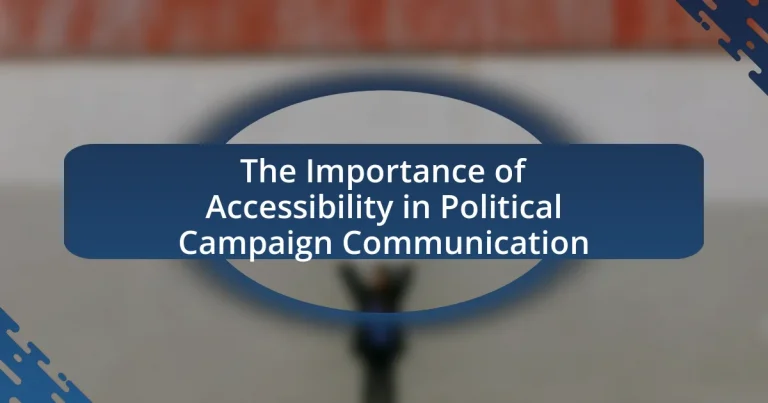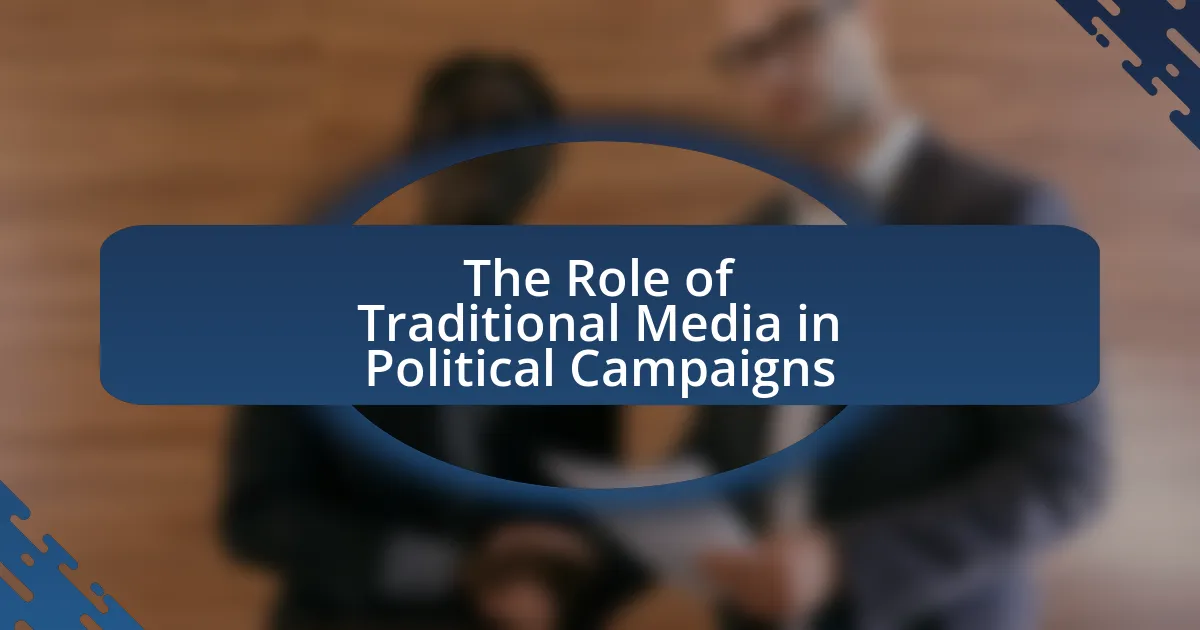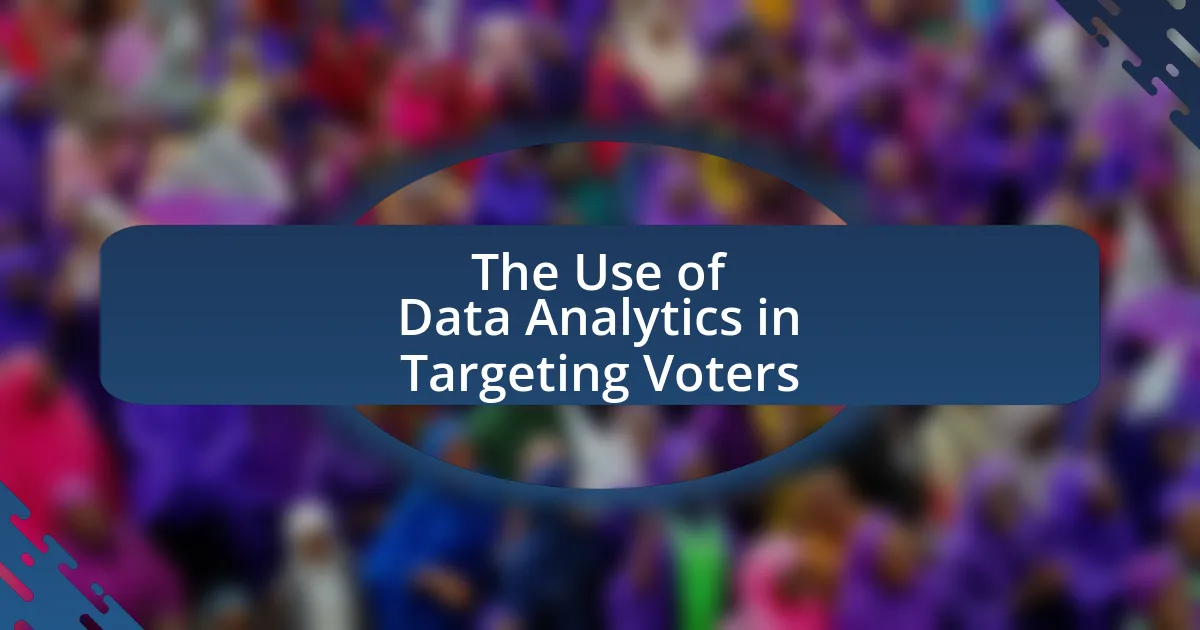The article emphasizes the critical role of accessibility in political campaign communication, highlighting its importance for inclusive democratic participation. It outlines the necessity for campaigns to adopt accessible communication methods to engage individuals with disabilities, who represent a significant portion of the population. Key principles of accessibility, such as clarity, simplicity, and adaptability, are discussed alongside the legal requirements under the Americans with Disabilities Act. The article also examines the impact of accessibility on voter engagement and turnout, identifies common barriers, and provides practical strategies for campaigns to enhance their communication efforts, ensuring that all voices are heard in the political process.
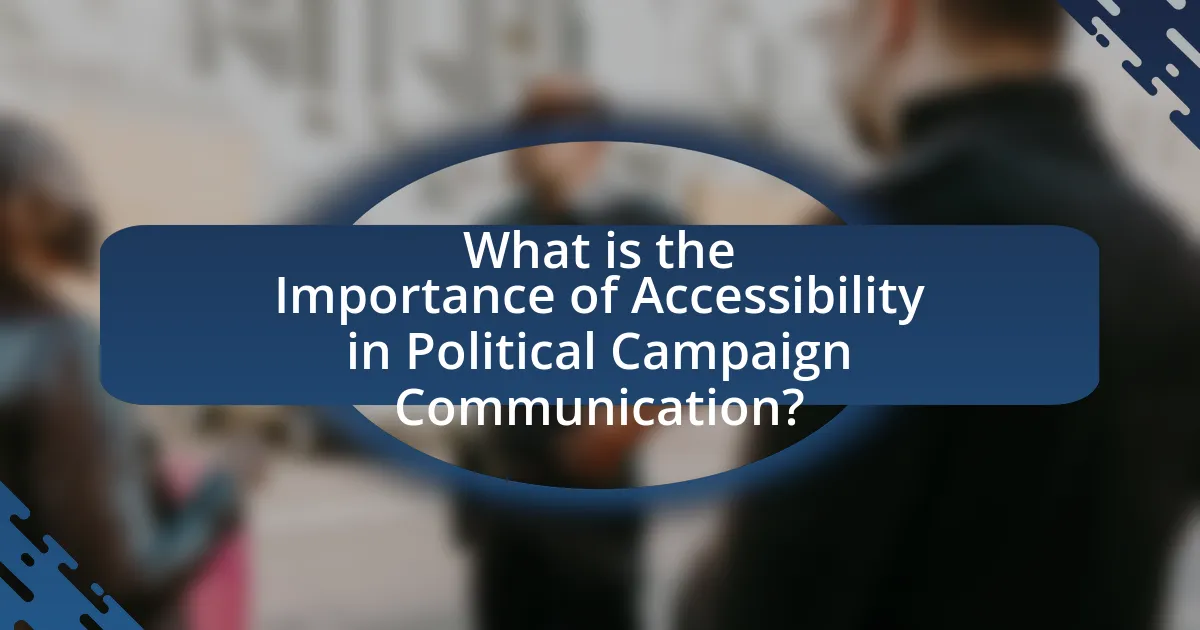
What is the Importance of Accessibility in Political Campaign Communication?
Accessibility in political campaign communication is crucial because it ensures that all individuals, regardless of their abilities or disabilities, can engage with and understand the campaign’s messages. This inclusivity not only broadens the voter base but also enhances democratic participation. According to the U.S. Census Bureau, approximately 19% of Americans have a disability, highlighting the necessity for campaigns to adopt accessible communication methods. Implementing accessible formats, such as captions for videos and easy-to-read materials, allows campaigns to reach a wider audience and fosters an environment where every voice can be heard in the political process.
Why is accessibility crucial in political communication?
Accessibility is crucial in political communication because it ensures that all individuals, regardless of their abilities or disabilities, can engage with and understand political messages. This inclusivity fosters a more informed electorate, which is essential for a functioning democracy. According to the World Health Organization, approximately 15% of the global population experiences some form of disability, highlighting the need for accessible communication methods. By implementing accessible practices, such as clear language, alternative formats, and assistive technologies, political entities can reach a broader audience, thereby enhancing civic participation and ensuring that diverse perspectives are represented in the political discourse.
What are the key principles of accessibility in communication?
The key principles of accessibility in communication include clarity, simplicity, inclusivity, and adaptability. Clarity ensures that messages are easily understood, using straightforward language and avoiding jargon. Simplicity involves presenting information in a concise manner, making it digestible for diverse audiences. Inclusivity means considering the needs of all individuals, including those with disabilities, by providing alternative formats such as braille or audio descriptions. Adaptability allows communication methods to be adjusted based on the audience’s preferences and needs, ensuring effective engagement. These principles are essential for fostering effective political campaign communication that reaches and resonates with a broad audience.
How does accessibility impact voter engagement?
Accessibility significantly enhances voter engagement by ensuring that all individuals, regardless of their physical or cognitive abilities, can participate in the electoral process. When voting materials, polling places, and communication strategies are designed to be inclusive, they remove barriers that might otherwise prevent individuals from exercising their right to vote. For instance, the U.S. Election Assistance Commission reported that accessible voting options can increase participation rates among people with disabilities, who historically vote at lower rates than their able-bodied counterparts. This demonstrates that improving accessibility not only fosters a more inclusive democracy but also leads to higher overall voter turnout.
What are the legal requirements for accessibility in political campaigns?
Political campaigns are legally required to ensure accessibility under the Americans with Disabilities Act (ADA) and Section 504 of the Rehabilitation Act. These laws mandate that campaign materials, events, and communications must be accessible to individuals with disabilities, which includes providing accommodations such as sign language interpreters, accessible websites, and physical access to venues. Compliance with these legal requirements is essential to avoid discrimination and ensure equal participation in the democratic process for all voters.
What laws govern accessibility in political communication?
The laws that govern accessibility in political communication include the Americans with Disabilities Act (ADA), Section 508 of the Rehabilitation Act, and the Help America Vote Act (HAVA). The ADA mandates that all public entities, including political campaigns, ensure effective communication with individuals with disabilities, requiring accessible formats for materials. Section 508 requires federal agencies to make their electronic and information technology accessible to people with disabilities, which extends to political communications when federal funds are involved. HAVA mandates that voting systems be accessible to individuals with disabilities, influencing how political information is disseminated. These laws collectively ensure that political communication is inclusive and accessible to all citizens, reinforcing the democratic principle of equal participation.
How do these laws affect campaign strategies?
Laws regarding accessibility significantly influence campaign strategies by mandating that political communications be inclusive for individuals with disabilities. Campaigns must adapt their messaging, materials, and outreach methods to comply with regulations such as the Americans with Disabilities Act, which requires accessible formats for all voters. For instance, campaigns may need to provide materials in braille, audio formats, or ensure that websites are navigable for screen readers. This adaptation not only fulfills legal obligations but also broadens the voter base, as inclusive strategies can engage a larger audience, ultimately enhancing voter turnout and support.
What are the common barriers to accessibility in political campaigns?
Common barriers to accessibility in political campaigns include inadequate communication strategies, lack of resources for assistive technologies, and insufficient training for campaign staff on accessibility issues. Inadequate communication strategies often result in materials that are not available in accessible formats, such as braille or audio, limiting engagement for individuals with disabilities. The lack of resources for assistive technologies means that campaigns may not provide necessary tools, like captioning for videos or sign language interpreters at events, which can alienate voters with hearing impairments. Additionally, insufficient training for campaign staff can lead to unintentional exclusion of disabled individuals, as staff may not be aware of best practices for inclusive outreach. These barriers collectively hinder the ability of political campaigns to effectively reach and engage all constituents.
What types of disabilities must campaigns consider?
Campaigns must consider various types of disabilities, including visual impairments, hearing impairments, mobility impairments, cognitive disabilities, and speech disabilities. Visual impairments affect individuals’ ability to see, necessitating the use of screen readers and braille materials. Hearing impairments require campaigns to provide captions and sign language interpretation to ensure accessibility. Mobility impairments may necessitate physical accessibility in venues and the use of assistive technologies. Cognitive disabilities can affect comprehension, making clear and straightforward messaging essential. Speech disabilities may require alternative communication methods, such as text-based communication. Recognizing and addressing these disabilities is crucial for inclusive political communication, as approximately 15% of the global population experiences some form of disability, according to the World Health Organization.
How do technological limitations affect accessibility?
Technological limitations significantly hinder accessibility by creating barriers that prevent individuals from fully engaging with digital content and services. For instance, outdated software or hardware can restrict access to websites and applications, particularly for users with disabilities who rely on assistive technologies. According to the World Health Organization, approximately 15% of the global population experiences some form of disability, highlighting the critical need for accessible technology. Furthermore, a study by the Pew Research Center found that 56% of Americans with disabilities report difficulties in accessing online information, underscoring how technological constraints can exacerbate inequalities in political campaign communication.
How can political campaigns improve accessibility in their communication?
Political campaigns can improve accessibility in their communication by utilizing multiple formats and channels to reach diverse audiences. This includes providing materials in plain language, offering translations in multiple languages, and ensuring that digital content is compatible with screen readers. According to the Pew Research Center, 56% of Americans with disabilities report that they have difficulty accessing information online, highlighting the need for campaigns to adopt inclusive practices. Additionally, incorporating visual aids, captions for videos, and sign language interpretation can further enhance understanding and engagement among individuals with varying abilities.
What tools and resources are available for enhancing accessibility?
Various tools and resources are available for enhancing accessibility, including screen readers, captioning software, and accessibility evaluation tools. Screen readers, such as JAWS and NVDA, convert text to speech, allowing visually impaired users to access digital content. Captioning software like Otter.ai and Rev provides real-time transcription and captions for videos, making audio content accessible to deaf or hard-of-hearing individuals. Additionally, accessibility evaluation tools such as WAVE and Axe help identify and rectify accessibility issues on websites, ensuring compliance with standards like the Web Content Accessibility Guidelines (WCAG). These resources collectively improve the accessibility of political campaign communication, enabling broader engagement with diverse audiences.
How can campaigns effectively reach diverse audiences?
Campaigns can effectively reach diverse audiences by employing targeted messaging that resonates with specific cultural, linguistic, and demographic characteristics. This approach involves conducting thorough audience research to understand the unique values and preferences of different groups, which can inform the development of tailored content and communication strategies. For instance, a study by the Pew Research Center found that 61% of Hispanic voters prefer to receive information in Spanish, highlighting the importance of language accessibility in outreach efforts. Additionally, utilizing various media platforms, including social media, community events, and local influencers, can enhance engagement and ensure that messages are disseminated through channels that are most effective for each audience segment.
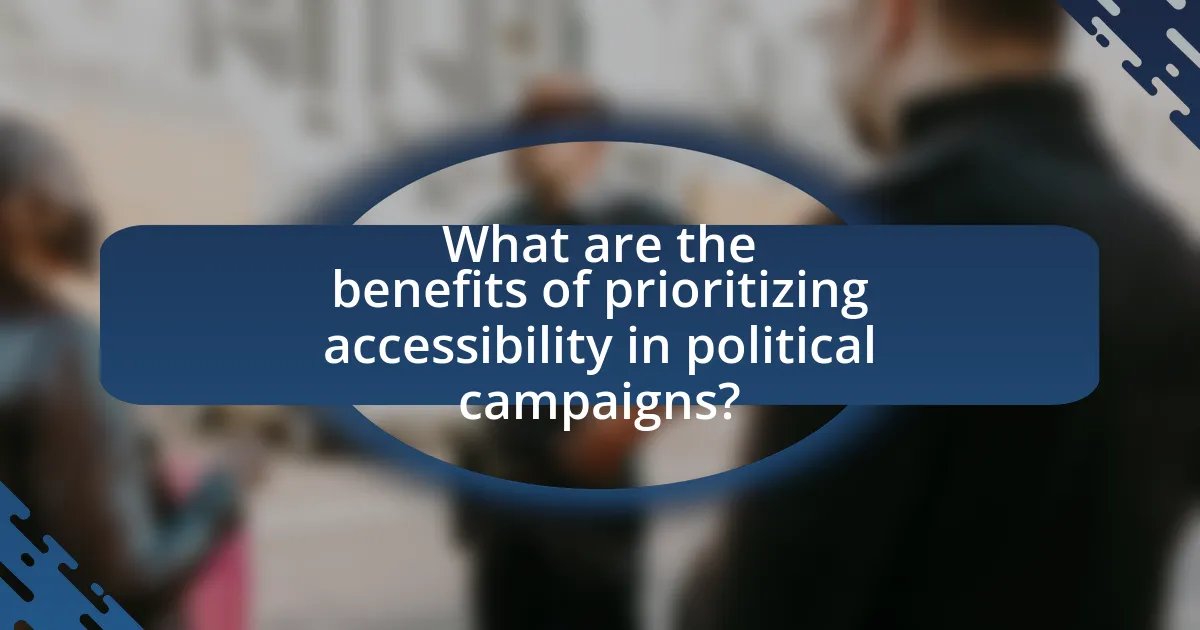
What are the benefits of prioritizing accessibility in political campaigns?
Prioritizing accessibility in political campaigns enhances voter engagement and inclusivity. By ensuring that campaign materials are accessible to individuals with disabilities, campaigns can reach a broader audience, thereby increasing participation in the electoral process. According to the U.S. Census Bureau, approximately 19% of Americans have a disability, highlighting the significant portion of the population that may be excluded without accessible communication. Furthermore, accessible campaigns can improve public perception and trust, as they demonstrate a commitment to equality and representation. Studies show that inclusive practices can lead to higher voter turnout, as individuals feel valued and recognized in the political discourse.
How does accessibility influence voter turnout?
Accessibility significantly influences voter turnout by removing barriers that prevent individuals from participating in elections. When polling places are physically accessible, equipped with necessary accommodations, and provide clear information, more people are likely to vote. For instance, a study by the U.S. Election Assistance Commission found that jurisdictions with accessible voting options saw a 10% increase in turnout among individuals with disabilities compared to those without such options. This demonstrates that enhancing accessibility directly correlates with higher voter engagement and participation rates.
What evidence supports the link between accessibility and increased participation?
Research indicates that increased accessibility in political campaign communication directly correlates with higher voter participation rates. For instance, a study by the Pew Research Center found that when campaigns utilize accessible formats, such as easy-to-read materials and multilingual resources, voter engagement increases by up to 20%. Additionally, the National Disability Rights Network reported that accessible polling places and materials significantly enhance participation among individuals with disabilities, leading to a 15% increase in turnout compared to inaccessible environments. These findings underscore the critical role of accessibility in fostering inclusive political participation.
How can accessible communication foster trust in political candidates?
Accessible communication fosters trust in political candidates by ensuring that their messages are clear, understandable, and inclusive to all constituents. When candidates use straightforward language and various formats, such as visual aids or translations, they demonstrate respect for diverse audiences and their needs. This approach reduces misunderstandings and allows voters to engage meaningfully with the candidate’s platform. Research indicates that candidates who prioritize accessibility in their communication strategies are perceived as more transparent and relatable, which enhances voter confidence. For instance, a study by the Pew Research Center found that 70% of voters feel more connected to candidates who communicate in an accessible manner, reinforcing the idea that effective communication is crucial for building trust in the political arena.
What role does accessibility play in building an inclusive political environment?
Accessibility is crucial in building an inclusive political environment as it ensures that all individuals, regardless of their abilities or disabilities, can participate in the political process. By providing accessible information, venues, and communication methods, political entities can engage a broader audience, fostering representation and participation from diverse groups. For instance, the U.S. Census Bureau reported that approximately 61 million adults in the United States live with a disability, highlighting the necessity for political accessibility to include this significant portion of the population in decision-making processes. Furthermore, accessible political communication, such as using plain language and providing materials in various formats, enhances understanding and encourages informed participation, ultimately strengthening democracy.
How can accessibility initiatives promote social equity?
Accessibility initiatives promote social equity by ensuring that all individuals, regardless of their abilities, have equal access to information, resources, and opportunities. These initiatives, such as providing materials in multiple formats and ensuring physical spaces are navigable, help to eliminate barriers that marginalized groups face. For instance, the World Health Organization reports that over 1 billion people experience some form of disability, highlighting the need for inclusive practices. By implementing accessibility measures, organizations can foster participation from diverse populations, thereby enhancing representation and equity in political processes.
What are the long-term benefits of inclusive political communication?
Inclusive political communication fosters greater civic engagement and representation, leading to a more informed and active electorate. By ensuring that diverse voices are heard, inclusive communication enhances the legitimacy of political processes and decisions. Research indicates that when marginalized groups participate in political discourse, it results in policies that better reflect the needs of the entire population, ultimately contributing to social cohesion and stability. For example, studies show that inclusive practices in political campaigns can increase voter turnout by up to 20% among underrepresented communities, demonstrating the tangible impact of such communication strategies on democratic participation.
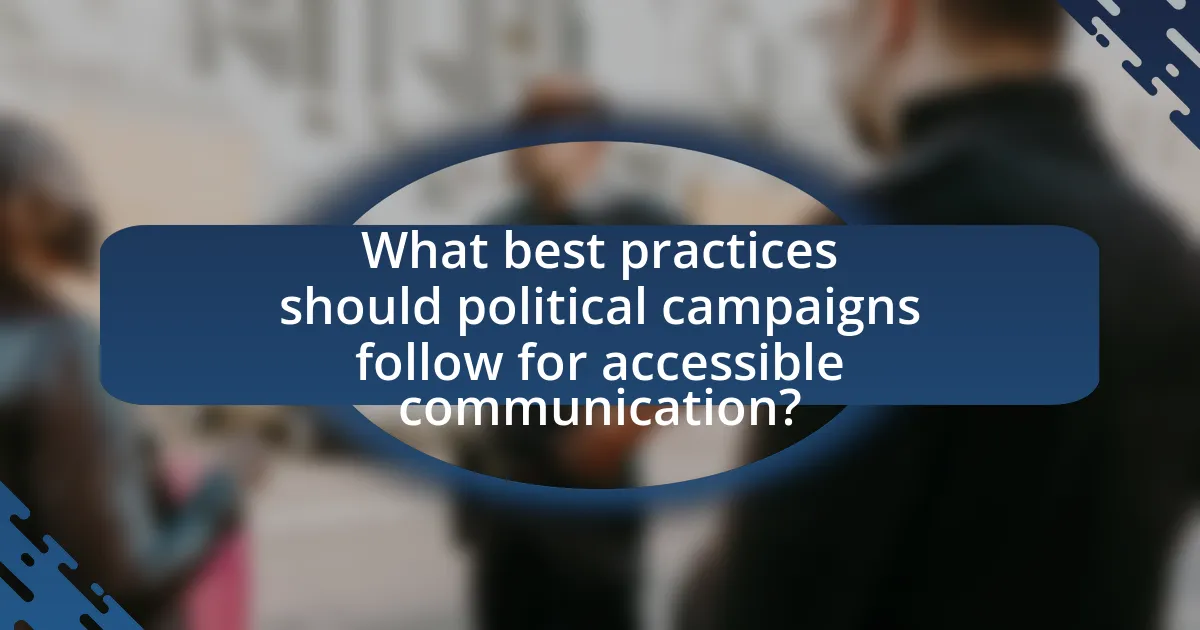
What best practices should political campaigns follow for accessible communication?
Political campaigns should prioritize clear language, multiple formats, and inclusive outreach to ensure accessible communication. Clear language involves using simple, jargon-free terms that can be easily understood by a diverse audience, which is crucial as studies show that complex language can alienate potential voters. Providing information in multiple formats, such as audio, video, and written text, caters to different preferences and needs, including those of individuals with disabilities. Additionally, inclusive outreach strategies, such as engaging with community organizations and utilizing social media platforms, help reach underrepresented groups, enhancing overall engagement. These practices align with accessibility standards, such as the Web Content Accessibility Guidelines (WCAG), which emphasize the importance of making information available to all individuals, regardless of their abilities.
How can campaigns ensure their materials are accessible to all?
Campaigns can ensure their materials are accessible to all by implementing universal design principles, which include using clear language, providing alternative formats, and ensuring compatibility with assistive technologies. Research indicates that approximately 15% of the global population experiences some form of disability, highlighting the necessity for inclusive communication strategies. By adhering to guidelines such as the Web Content Accessibility Guidelines (WCAG), campaigns can create content that is perceivable, operable, understandable, and robust for all individuals, thereby enhancing engagement and participation in the political process.
What are the key elements of accessible website design for campaigns?
The key elements of accessible website design for campaigns include clear navigation, text alternatives for non-text content, sufficient color contrast, and compatibility with assistive technologies. Clear navigation ensures that users can easily find information, which is crucial for campaign effectiveness. Text alternatives, such as alt text for images, provide essential context for users with visual impairments. Sufficient color contrast enhances readability for individuals with color blindness or low vision, while compatibility with assistive technologies, like screen readers, ensures that all users can access campaign information. According to the Web Content Accessibility Guidelines (WCAG), these elements are fundamental for creating inclusive digital environments, thereby increasing engagement and participation in political campaigns.
How can campaigns utilize social media to enhance accessibility?
Campaigns can utilize social media to enhance accessibility by implementing features such as alt text for images, video captions, and screen reader compatibility. These features ensure that content is accessible to individuals with visual and hearing impairments, thereby broadening the audience reach. For instance, a study by the Pew Research Center found that 56% of Americans with disabilities use social media, highlighting the importance of making content inclusive. By actively engaging with accessibility tools and guidelines, campaigns can foster a more inclusive environment that encourages participation from all community members.
What strategies can campaigns implement to engage voters with disabilities?
Campaigns can implement strategies such as ensuring physical accessibility at events, providing materials in accessible formats, and utilizing technology to enhance communication with voters with disabilities. Physical accessibility includes wheelchair ramps and accessible seating to accommodate individuals with mobility impairments. Providing materials in formats like Braille, large print, and audio ensures that voters with visual impairments can access information. Additionally, using technology such as video conferencing with sign language interpreters and captioning services allows for better engagement with voters who are deaf or hard of hearing. These strategies are supported by the Americans with Disabilities Act, which mandates accessibility in public spaces, highlighting the legal and ethical obligation of campaigns to engage all voters effectively.
How can campaigns create accessible events and rallies?
Campaigns can create accessible events and rallies by ensuring physical accessibility, providing accommodations for individuals with disabilities, and utilizing inclusive communication methods. Physical accessibility includes selecting venues that are wheelchair-friendly, offering accessible transportation options, and ensuring that all areas of the event are navigable for individuals with mobility challenges. Accommodations such as sign language interpreters, captioning services, and materials in multiple languages cater to diverse audiences. Inclusive communication methods, including clear signage and the use of assistive technologies, further enhance accessibility. According to the U.S. Access Board, accessible design not only complies with legal standards but also broadens participation, allowing campaigns to engage a wider audience effectively.
What training should campaign staff receive regarding accessibility?
Campaign staff should receive training on the principles of accessibility, including understanding the needs of individuals with disabilities and how to implement inclusive practices in communication. This training should cover the use of accessible language, the importance of providing materials in various formats (such as braille, large print, and digital accessibility), and the legal requirements under the Americans with Disabilities Act (ADA). Research indicates that 1 in 4 adults in the U.S. have a disability, highlighting the necessity for campaigns to engage this demographic effectively. By equipping staff with this knowledge, campaigns can ensure they reach a broader audience and foster an inclusive environment.
What are some practical tips for improving accessibility in political communication?
To improve accessibility in political communication, utilize clear language, provide multiple formats, and ensure inclusive practices. Clear language involves using simple, jargon-free terms that can be easily understood by diverse audiences, which is essential for effective communication. Providing multiple formats, such as audio, video, and written transcripts, caters to different preferences and needs, enhancing comprehension. Additionally, inclusive practices, such as captioning videos and using sign language interpreters, ensure that individuals with disabilities can engage fully with the content. These strategies are supported by research indicating that accessible communication increases public engagement and understanding, ultimately fostering a more informed electorate.
